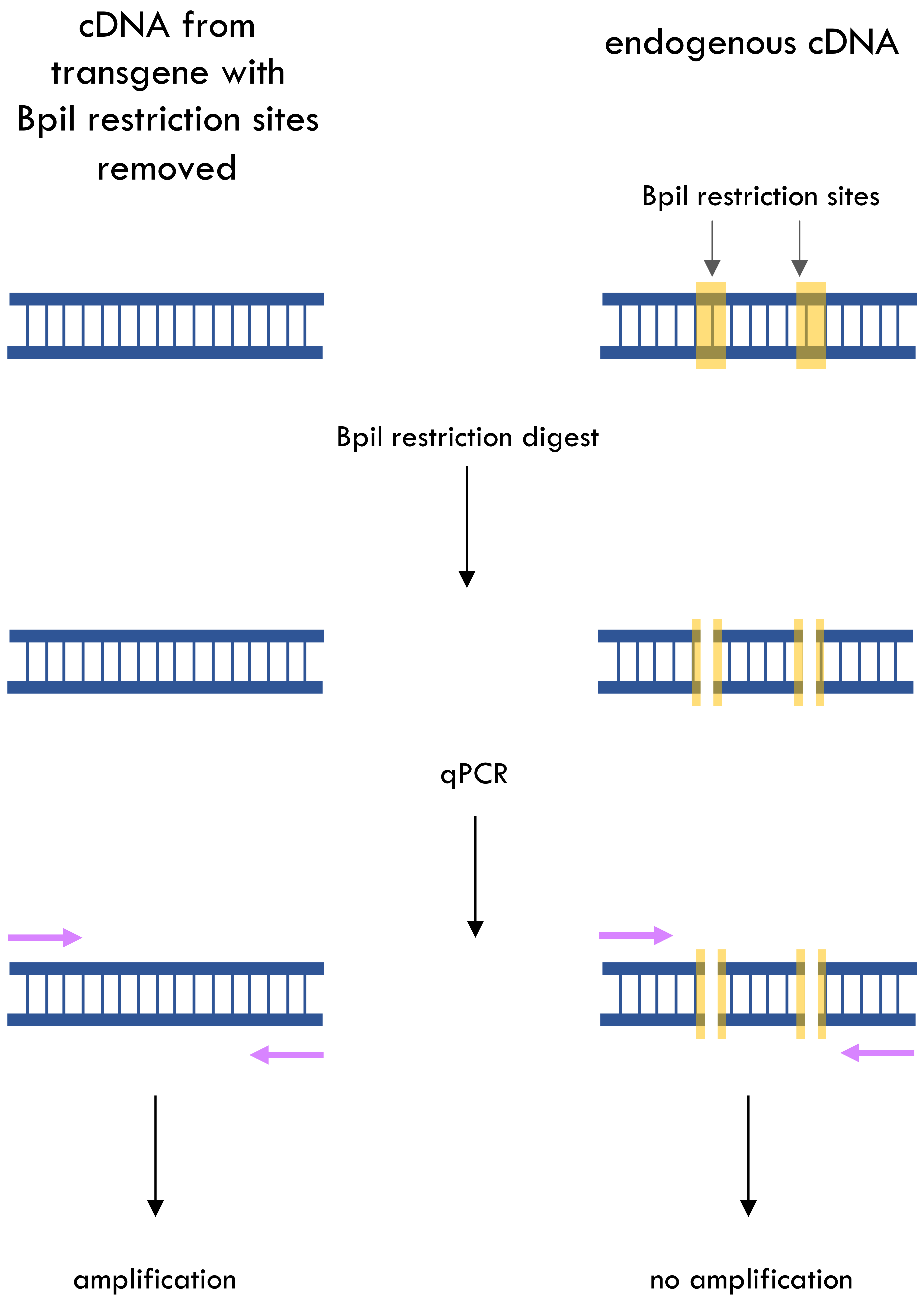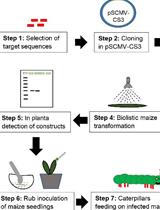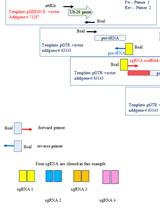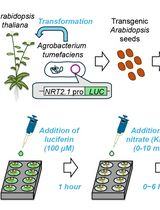- EN - English
- CN - 中文
A qPCR Method to Distinguish between Expression of Transgenic and Endogenous Copies of Genes
区分转基因和内源拷贝表达的qPCR方法
发布: 2023年08月05日第13卷第15期 DOI: 10.21769/BioProtoc.4784 浏览次数: 1604
评审: Anonymous reviewer(s)
Abstract
Study of gene function in eukaryotes frequently requires data on the impact of the gene when it is expressed as a transgene, such as in ectopic or overexpression studies. Currently, the use of transgenic constructs designed to achieve these aims is often hampered by the difficulty in distinguishing between the expression levels of the endogenous gene and its transgene equivalent, which may involve either laborious microdissection to isolate specific cell types or harvesting tissue at narrow timepoints. To address this challenge, we have exploited a feature of the Golden Gate cloning method to develop a simple, restriction digest–based protocol to differentiate between expression levels of transgenic and endogenous gene copies. This method is straightforward to implement when the endogenous gene contains a Bpi1 restriction site but, importantly, can be adapted for most genes and most other cloning strategies.
Key features
• This protocol was developed to determine the expression level of an ectopically expressed transcription factor with broad native expression in all surrounding tissues.
• The method described is most directly compatible with Golden Gate cloning but is, in principle, compatible with any cloning method.
• The protocol has been developed and validated in the model plant Arabidopsis thaliana but is applicable to most eukaryotes.
Graphical overview

Background
Quantifying specific spatial or temporal expression of a transgenically expressed endogenous gene against a background of high or overlapping expression of the native endogenous sequence remains a long-standing problem in eukaryotic molecular research. To overcome this, we have developed a protocol based on the introduction of a synonymous mutation into the transgenic copy of the endogenous gene to remove a restriction enzyme cleavage site. This is frequently a feature of the assembly of Golden Gate Cloning constructs (the so-called domestication process, involving excision of key Type IIS restriction nuclease sites) (Engler et al., 2008; Weber et al., 2011). This restriction site difference can then be exploited to differentiate between endogenous and transgenic expression by digesting complementary DNA (cDNA) from transgenic individuals with the relevant restriction enzyme, which will cleave endogenous cDNA but will leave the transgene cDNA uncut. Misexpression of an endogenous gene in a tissue where it is not normally expressed using a cell type–specific promoter is a commonly used experimental technique (Prelich, 2012). However, if that cell type is temporally or spatially difficult to isolate, it can be challenging to determine accurately the levels of overexpression that have been achieved without technically complex and laborious dissection. The protocol removes the need to isolate the specific cell types to confirm expression but instead allows this to be done on RNA extracted from bulk tissues.
Essentially, the protocol set out below involves making a domesticated version of the transgene missing a restriction site present in the endogenous sequence and transforming it into the organism under study. Following RNA extraction and standard reverse transcription, an additional digestion step is introduced whereby the cDNA is restricted using the enzyme targeting the site now only present in cDNA from the endogenous gene. Subsequent qPCR, using primers amplifying a region of the gene containing the restriction site, will thus only amplify cDNA specific to the transgene, leaving the endogenous cDNA unaffected—since it can no longer serve as a template for amplification. qPCR on this digested cDNA using primers amplifying a region of a housekeeping gene that does not contain the restriction site allows the calculation of relative expression levels using the 2-ΔΔC(T) method (Livak and Schmittgen, 2001). Although this protocol is simplest to implement in cases where Golden Gate cloning is used and an endogenous Bpi1 restriction enzyme cut site has been removed, with planning during cloning this same principle can also be adapted to any other cloning strategy by the introduction of a synonymous mutation that removes a restriction enzyme cleavage site from the transgene. Overall, this technique allows very rapid and accurate estimation of the transgene expression level, as negligible endogenous cDNA survives cleavage and thus expression levels detected by qPCR reflect only the transgene. cDNA from wildtype organisms can, of course, be used to determine approximate control levels of endogenous gene expression and, in the case of inducible transgenes, a more accurate estimate of endogenous gene expression can be obtained by sampling cDNA from uninduced tissue.
This method was developed by Bezodis et al. (2022) to detect expression from inducible constructs that ectopically express high levels of homeodomain transcription factors in a spatially and temporally restricted region of the germline lineage of the model plant Arabidopsis thaliana. While the transcription factors of interest are normally not expressed in the germline, they are expressed significantly throughout the surrounding somatic tissues. These endogenous transcripts thus constitute a major component of the RNA collected from whole tissues but, by digesting cDNA from the endogenous gene copy carrying the functional restriction site, this method avoids the laborious task of dissecting out cells in which only the transgene is expressed. The combination of this qPCR strategy and the use of imaging markers has permitted both the location and extent of transgene expression to be accurately determined using promoters driving expression in specific germline cell types over a short period. We have found the use of an inducible system to be particularly helpful, as it provides a control expression level to confirm that the digest has worked effectively at removing expression of the endogenous gene and matching construct-driven expression to observed phenotypes (Bezodis et al., 2022). Induction uses a two-component LhGR/pOp6 expression system (Craft et al., 2005) and a protocol for this system has been published (Samalova et al., 2019), including for use in reproductive tissues (Schubert et al., 2022). We note, however, that the protocol does not require an inducible system, nor is it limited to Arabidopsis or, in fact, to plants.
Materials and reagents
Biological materials
Gene synthesis; GeneArt Gene Synthesis (Thermo Fisher Scientific, UK)
Laboratory supplies
RNeasy Plant Mini kit (Qiagen, catalog number: 74904)
RNase-free DNase set (Qiagen, catalog number: 79254)
Bpi1 (Bbs1) restriction enzyme (Thermo Fisher Scientific, catalog number: ER1011)
qPCRBIO cDNA synthesis kit (PCR Biosystems Ltd, catalog number: PB30.11-10)
SuperScriptTM IV First-Strand Synthesis System (Thermo Fisher Scientific, catalog number: 18091050)
qPCR SyGreen Mix (PCR Biosystems Ltd, catalog number: PB20.12-05)
qPCR plates (Applied Biosystems, Thermo Fisher Scientific, catalog number: 4346906)
Microamp Fast Optical 96-well reaction plates with barcode (Thermo Fisher Scientific, catalog number 4346906)
Adhesive PCR plate seals (Thermo Scientific, catalog number: AB-0558)
Equipment
MiniAmp thermal cycler (Thermo Fisher Scientific)
StepOnePlus real-time PCR system (Applied Biosystems, Thermo Fisher Scientific)
NanoDrop (Thermo Scientific, Labtech, ND1000, Thermo Fisher Scientific)
Software
Construct design and sequence analysis was carried out using SnapGene software (www.snapgene.com); a plasmid editor, ApE, is a suitable freely available alternative (Davis and Jorgensen, 2022)
qPCR data analysis was performed using Thermo Fisher Data Connect Design & Analysis Software
Procedure
文章信息
版权信息
© 2023 The Author(s); This is an open access article under the CC BY-NC license (https://creativecommons.org/licenses/by-nc/4.0/).
如何引用
Bezodis, W., Prescott, H., Vlad, D. and Dickinson, H. (2023). A qPCR Method to Distinguish between Expression of Transgenic and Endogenous Copies of Genes. Bio-protocol 13(15): e4784. DOI: 10.21769/BioProtoc.4784.
分类
分子生物学 > DNA > DNA 克隆
分子生物学 > DNA > 基因表达
您对这篇实验方法有问题吗?
在此处发布您的问题,我们将邀请本文作者来回答。同时,我们会将您的问题发布到Bio-protocol Exchange,以便寻求社区成员的帮助。
提问指南
+ 问题描述
写下详细的问题描述,包括所有有助于他人回答您问题的信息(例如实验过程、条件和相关图像等)。
Share
Bluesky
X
Copy link












